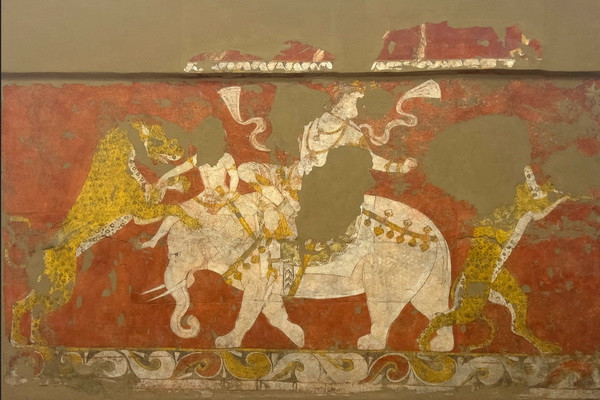Tashkent: On 26 September 2024, the Silk Roads exhibition will open at the British Museum London, UK in the Sainsbury Exhibition Gallery. 14 exhibits from museum collections in Uzbekistan will be shown in the main museum of Great Britain.
The general public’s idea of the Silk Road and its structure is quite popular – camel caravans crossing sand dunes, traders exchanging silks and spices in bazaars. The exhibition at the British Museum will challenge this view and provide a richer picture of more than just the history of trade between East and West, revealing a complex web of connections spanning societies and cultures across Asia, Africa, Europe, from Japan to Britain, Scandinavia to Madagascar.
“The British Museum is world renowned for its exciting, award-winning exhibitions, which I have always admired. Silk Roads will be my first exhibition project since becoming director, and I am particularly excited by the way it challenges existing assumptions, providing a unique opportunity for international cultural collaboration.” – Nicholas Cullinan, Director of the British Museum.
Large in scope and vast in geographical scope, Silk Roads will demonstrate how the movements of people, objects and ideas along the Silk Road helped shape culture and history. Roads have been in use for thousands of years, and the upcoming exhibition will focus on the defining period of their history, from 500 to 1000 AD. AD
The exhibition includes five geographical zones, opening the way for visitors along their own roads of the Silk Road, showcasing more than 300 exhibits from various museum collections. From Indian garnets found in Suffolk to Iranian glass discovered in Japan, these objects reveal a surprisingly wide range of Silk Road trade networks.
“We continue our international cooperation to demonstrate the unique cultural and historical heritage of Uzbekistan. The Silk Roads exhibition at the British Museum will help demonstrate to the general public the contribution of Central Asia to the development of world culture and history, as well as the uniqueness and diversity of our exhibits from museum collections in Uzbekistan. Cooperation with a leading British cultural institution is an important step towards strengthening cultural ties between our countries,” Gayane Umerova, Chairman of the Foundation for the Development of Culture and Art of Uzbekistan, said.
Many of the items will be shown in London for the first time, including one of the oldest sets of chess pieces and a monumental six-meter wall painting from the “Hall of Ambassadors” in Afrosiab (Samarkand), Uzbekistan. The painting gives insight into the cosmopolitanism of the Sogdians from Central Asia, who played a key role in international trade during this period.
The Art and Culture Development Foundation of Uzbekistan presented 14 exhibits from the country’s museum collections for the Silk Roads exhibition. Among them: a wall painting of the Red Hall of the Varakhsha Palace (VIII century), an ossuary with a lid (VI-VII centuries), a silver dish with Sogdian inscriptions (V century), a jug from Kafir-Kala (VI-VII centuries) and other unique archaeological finds demonstrating the importance of Central Asia in the history of the Silk Road.
Such a large-scale project in terms of its meaning was developed by a group of curators at the British Museum.
“Our goal is to tell the broader, more complex story of the Silk Road beyond the perspective of East-West trade, emphasizing the interconnectedness of Asia, Africa, and Europe between 500 and 1000 CE. AD We are very excited about the international collaboration and the exhibits on display, which will be shown alongside items from the British Museum collection. It was truly a collaborative effort, in the spirit of the Silk Road,” said Luke Yu-Ping, Curator of Chinese Paintings, Prints and Central Asian Collections.
“It is extremely exciting to expand the history of the Silk Road into parts of the world that are not traditionally associated with the famous image in the minds of visitors. For example, visitors will see a whale bone box made in the northeast of England, which has stories and legends behind it. This is an amazing piece that truly embodies the breadth of intercontinental connections between 500 and 1000 AD,” Sue Brunning, Curator of European Early Medieval and Sutton Hoo Collections, added.
“This history of the Silk Road includes many journeys spanning the distance from the Pacific to the Atlantic Ocean. From empires to individuals, we sought to show the range of networks that facilitated movement, both voluntary and forced. It is our great privilege to present the stories of diplomats and pilgrims, scholars and students, refugees and captives, traders and trade goods to our visitors,” Elizabeth R. O’Connell, Curator of the Byzantine World, said.
Visitors to the exhibition will also discover personal stories, including Willibad, the resourceful balm smuggler from England, and the legendary Chinese princess who shared the secrets of sericulture with her new kingdom. Passing through deserts, mountains, rivers and seas, the Silk Road reveals a history of connections between cultures and continents long before the development of the modern world we know today.
A scientific catalog Silk Roads will be published for the exhibition.
On the eve of the opening of the exhibition, the stage of the London Coliseum Theater will host performances by the National Orchestra of Uzbekistan and Kirill Richter, who will present their work Sands of Time to the public, as well as a performance by the National Ballet of Uzbekistan with a spectacular ballet performance “Lazgi. Dance of soul and love.”
The Silk Roads exhibition will be on display from 26 September 2024 to 23 February 2025 in the Sainsbury Exhibitions Gallery at the British Museum.








